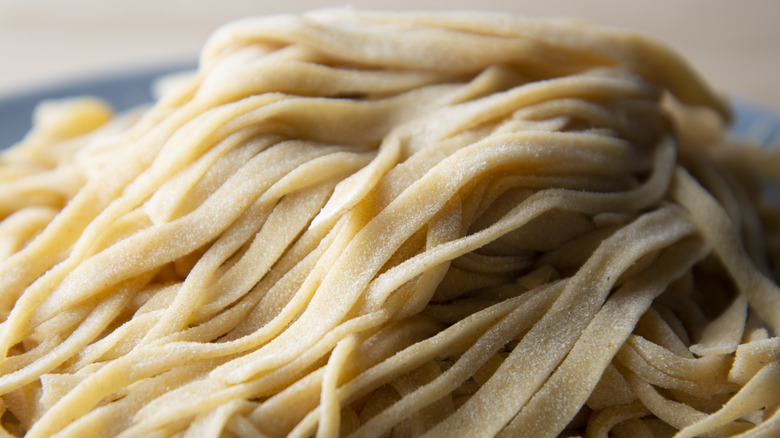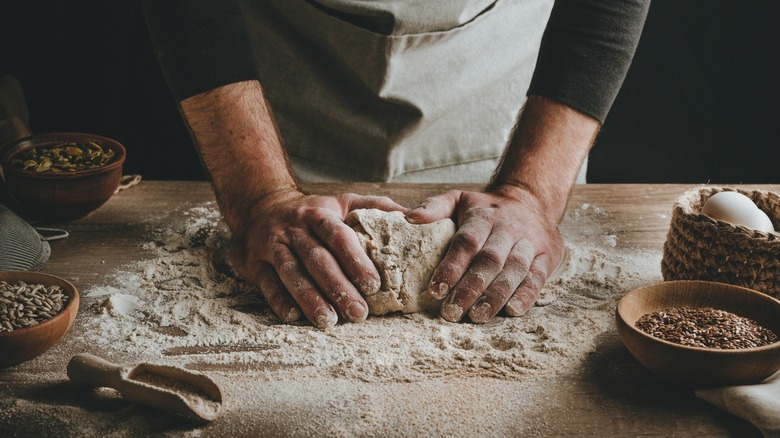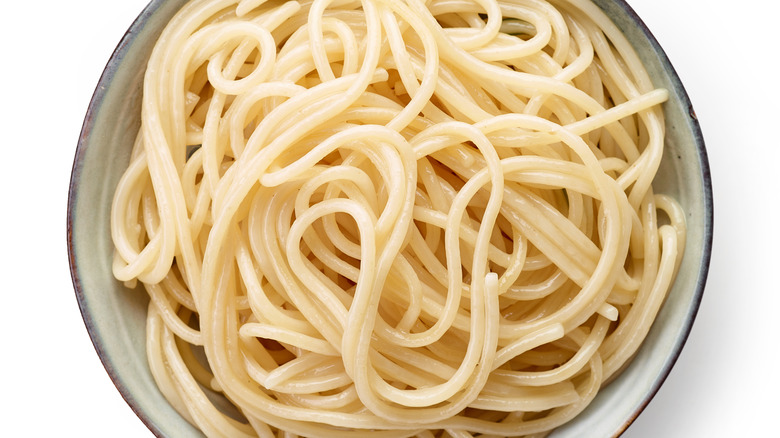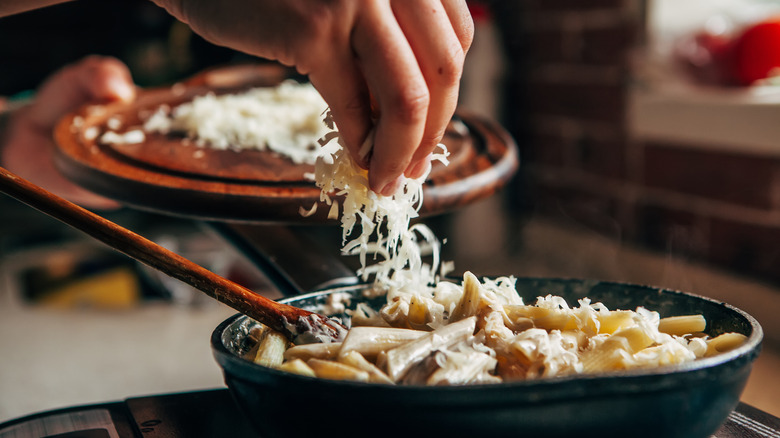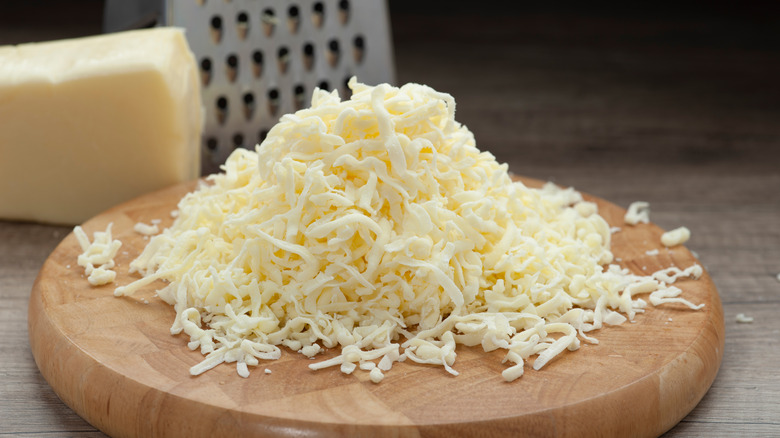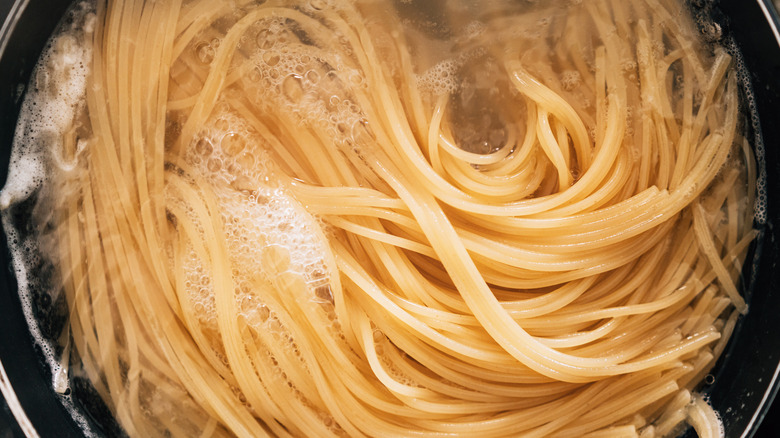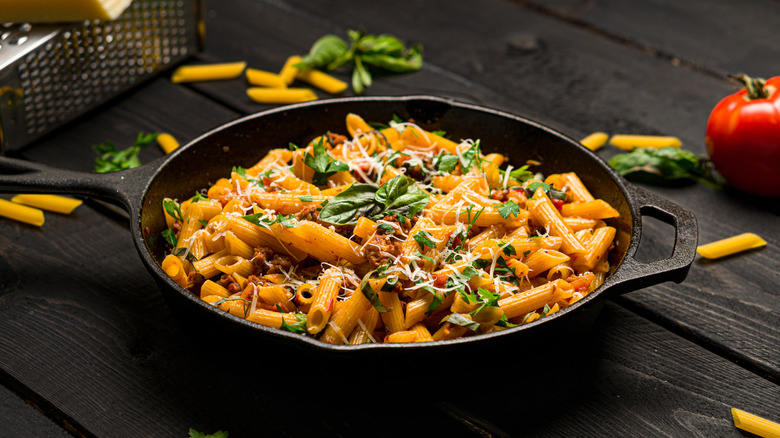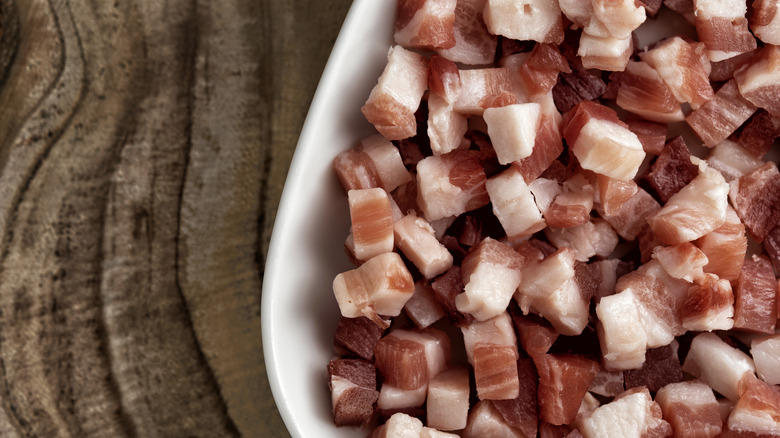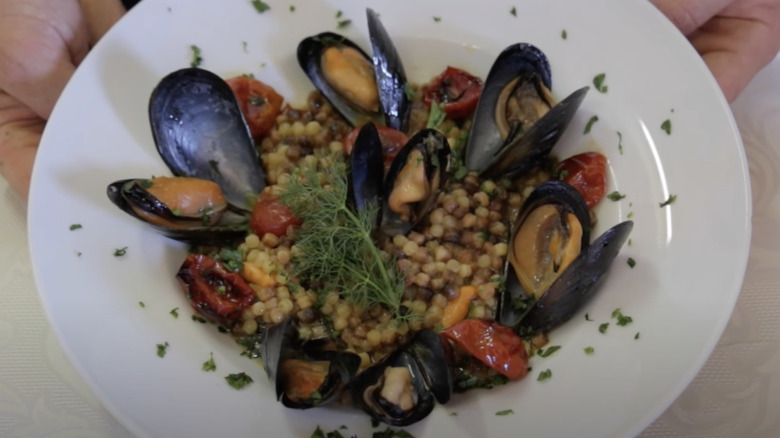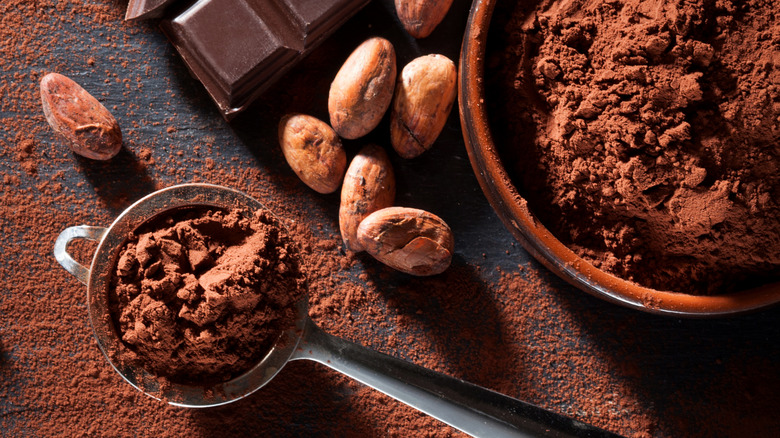13 Pasta Tips We Learned From Giada De Laurentiis
Giada De Laurentiis knows a thing or two about great pasta, as she's been a reliable source for easy and accessible Italian cuisine for nearly two decades now. Food played a large part in her childhood, planting a culinary seed that later blossomed into the Emmy award-winning celebrity chef she is today. With a cozy charm and infectious smile, Laurentiis strips traditional dishes down to the bare essentials without losing authentic taste. From basic staples like spaghetti to Italian classics like pasta alla Gricia, she puts the "al bacio" into home-friendly recipes.
With only a few simple ingredients, anyone can quickly whip up a restaurant-quality pasta dish. Pasta perfection comes with a catch though — it's as easy to perfect as it is to get wrong. Whether your noodles are stuck in a sticky situation, or your marinara is more gnarly than merry, there's a few things you can learn from De Laurentiis. She has the sauce, and know-how, to help any burgeoning home chef elevate authentic Italian food. Below, we've put together a list of tips that will turn your pasta dreams into reality, all while saving you extra time and money.
Enhance store-bought pasta sauce with other flavors
When you're on a budget, being resourceful in the kitchen can mean the difference between a boring meal and a satisfying end to a long day. Few foods are quick and easy to cook like pasta, which makes it a great option for those with busy schedules. Unfortunately, without some variety, you can easily get tired of the taste. Sometimes the best cooking tips involve a dash of curiosity, mixed with a sprinkle of "why not?" Leave it to De Laurentiis, who recommends putting extra oomph into your everyday store-bought pasta sauce by blending it with other ingredients.
While you can't beat the time-saving ease of store-bought pasta, that doesn't mean you have to stay lost in the sauce. Laurentiis enhances the everyday ordinary by adding garlic, onion, reserved Parmesan rinds, fresh herbs, Calabrian chili paste, and butter. Any combination of ingredients has the potential to bring delicious newness to your pasta dish. Try sautéed garlic and onion, Kalamata olives, and rosemary for an extra punch of aromatic savoriness. And of course, ground meat is always a safe bet. That way, you'll avoid flavor fatigue and potential complaints from kids exclaiming "not pasta again!"
Use quality ingredients when making pasta from scratch
Nothing makes pasta feel more authentically Italian than when it's made from scratch. The very act of it exudes a sense of fine dining, impressing hungry onlookers and sparking conversation. While fresh pasta isn't always better than dried varieties, knowing how to make it from scratch is a skill every serious home chef should have. If only to enjoy the taste of the real deal from time to time. For De Laurentiis, the key to delicious pasta at home is quality ingredients.
Pasta only requires a few ingredients: flour, olive oil and/or eggs, and salt. With so few components, she emphasizes the importance of making sure that each is top-notch. Purchase the high-priced olive oil you typically give the side-eye. Find out whether you prefer organic or free-range eggs. Use a finely-grained flour that's ideal for kneading. She promises the satisfying experience that awaits is worth the extra effort. Along with quality ingredients, De Laurentiis also lists workspace, because making pasta from scratch requires decent-sized kitchen counters. To round out the list, her third and final important key to excellent pasta is to weigh your ingredients. Without the proper measurements, you run the risk of ruining your homemade pasta.
Time and muscle are kneaded for homemade pasta
Two unlikely factors for making homemade pasta successfully are time and muscle. After you've acquired quality fresh ingredients, and you're ready to make this Italian classic from scratch, you'll knead to practice Chef De Laurentiis' essential tip. There's no way around it, mixing dough requires rolling up your sleeves and getting your hands dirty. With the right touch, you can skip the arm curls, and still enjoy a crave-worthy pasta dish. First things first, stretch for five to 10 minutes to make sure your muscles are flexible and ... just kidding. While it will take a little push and pull, stretching isn't necessary at all.
The goal is smooth pasta, and you can only achieve it by applying the right amount of force. If you don't properly and patiently, knead your dough, it can fall apart during the resting stage; that means starting from scratch. You'll need to devote a good five to eight minutes to kneading dough when making fresh pasta. Sadly, there's no shortcut or cheat code for quality noodles. One thing's for sure, though — when you experience the difference in taste and consistency, you'll be all the more thankful you took the time.
Save leftover pasta noodles for future recipes
Whenever pasta-ble, food should never go to waste. You'll save time, money, and energy by making recipes that put leftovers to use. This is especially true for pasta noodles, which are commonly cooked in larger batches than available sauce. How many times have you opened your fridge, wondering what to eat, only to scan past the leftover spaghetti? You can avoid having to perform a "sniff" test by plotting out multiple recipes for your extra uncooked pasta.
Although your travels may begin with fettuccine alfredo, you can easily plan a visit to baked ziti, or divert to chicken noodle soup. There's an endless array of flavor destinations you can take leftovers to. You'll not only save time, but you'll also keep things interesting too, all without leaving the comfort of your kitchen. In Italy, when your fridge is filled with leftover pastas, it's common to combine the various types. It's called "pasta mista," or mixed pasta, and even popular brands blend and box together random cuts. Next time you're scratching your noodle about what to do with leftover pasta, try this tip.
Reheat and revitalize leftover noodles with pan-frying
Revitalizing leftover noodles isn't rocket science, but if you're looking to capture that "just-cooked" freshness, you should follow the unique way Chef De Laurentiis reheats pasta. Move over microwave, this nuke-free approach is not necessarily meant to refresh your pasta, but rather reward you with a completely new dish. De Laurentiis was inspired by Asian-style pan-fried noodles when she stumbled upon this quick and easy method that only requires a little olive oil and a pan.
Overnight, pasta tends to absorb some of the sauce, resulting in dry leftovers. The downside is that using a microwave only intensifies the dryness, whereas pan-frying brings the upside of additional crispiness. Using medium heat, toss your leftover noodles with a bit of hot olive oil for three to four minutes. Monitor the pasta, making sure to stir and add more oil if needed. After it's browned a little and has a tiny crunch, it's ready to be served and enjoyed like new. What's great about this method is that you can also add greens and extra seasoning to the pasta.
Grate cheese into your pasta before adding sauce
Somewhere along our culinary timeline, a genius introduced cheese to pasta, altering reality as we know it. For something now considered normal, it must've been groundbreaking at the time. Hailing from a lineage of Italian cuisine connoisseurs, it makes sense that De Laurentiis knows the best way to add cheese to pasta. The tip was passed down by her grandfather, who she lovingly refers to as "Nonno." Before adding pasta to your sauce, you should grate cheese into your pasta. Never the other way around.
According to her, the idea originates from how Neapolitans used to make pasta. For a meltier, more evenly delicious experience, add grated cheese to fresh and warm un-sauced noodles. De Laurentiis prefers using Parmesan, but grated mozzarella, ricotta salata, or any cheese of your choosing will taste just as good. Another great thing about this method is that melted cheese helps sauce stick to noodles better, you'll discover its melty goodness in every bite. As you can see, and taste, the little things always make all the difference.
Remove pasta from boiling water when it's al dente
As straightforward as it is to cook pasta, both the order of the steps you take and the timing of those steps make a huge difference. According to Chef De Laurentiis, one of the biggest pasta mistakes people make is trying to take shortcuts. Understandably, even a few minutes can feel like a lifetime to a hungry stomach. But if you're looking for a truly tasty meal, a little patience goes a long way.
De Laurentiis considers one rule absolutely unbreakable: When your pasta becomes al dente, it's time to remove it from the boiling water. In Italian cuisine, al dente means "to the tooth," which is another way of saying your pasta has some bite to it. The reason you should retain a little firmness is that, traditionally, you finish cooking the al dente pasta in the sauce. That's how you avoid overcooked, limp, and soggy noodles, also known as "scotta" to Italians.
Save time by making one-pot pasta
If only we could instantly make any recipe we desired with a snap of the finger. Tearfully, since none of us are Merlin, we must find ways to speed up the cooking process — without sacrificing flavor of course. Le Cordon Bleu training aside, De Laurentiis knows the importance of simplifying and saving time in the kitchen. That's why she thinks one-pan pasta is a great time-saving way to prepare meals. When you're caught in a time-pinch, using only one pot reduces dirty dishes and cooking time.
Being a celebrity chef with a busy schedule, it makes sense that De Laurentiis would enjoy one-pot cooking. One recipe she's shared is the savory pasta alla formiana, which includes robust tomato sauce, peppery garlic, earthy olive oil, and aromatic oregano. It takes an hour to cook, but only six minutes to prepare. Another popular one is her one-skillet lasagna, made with spicy Italian sausage, tangy shallots, finely minced garlic, trimmed broccoli rabe, and three types of cheese. Each recipe takes only around an hour with minimal clean-up afterward. They're also awesome for stretching meals for tomorrow's dinner.
Make your carbonara nice and silky with pasta water
Rich, creamy, silky: These are all words that describe carbonara, one of the tastiest pastas in the world. It's made from a delicious combination of cured pork and cheesy Parmesan or earthy-flavored pecorino mixed with fresh eggs. With all of those amazing flavors, what could possibly go wrong? Well, too much of one ingredient or too little of another will result in a carbo-no-no. The last thing you want is a watery, overcooked, and flavorless forkful of pasta.
It just so happens that Chef De Laurentiis has a handy trick for silky carbonara, and it involves pasta water. Keeping in mind that "watery" sauce is bad, pasta water actually serves a great purpose. When making pasta carbonara, she keeps hot pasta water handy and uses it to prepare the raw egg and cheese mixture, before blending in the cured pork. Tempering is a method of obtaining a silky texture by combining cold beaten eggs with a hot liquid. In this case, the hot pasta water warms the egg mixture without totally cooking them.
Bacon and pancetta are tasty substitutes for guanciale
A recurring ingredient you'll find in Italian cuisine is cured pork. From creamy carbonara to spaghetti al guanciale, it's a savory meat that's a welcomed addition to any pasta party. Sadly, since many of us aren't blessed to reside within walking distance of an Italian deli, finding specific meats can sometimes be hard. While many traditional Italian classics may call for guanciale, the preferred cured pork of central Italy, you can still enjoy a palate-pleasing pasta alla Gricia with other types.
Chef De Laurentiis knows how to find accessible guanciale substitutes for pasta recipes. If your local grocery store only carries a general selection, bacon is a more than delicious enough alternative. Although more specialty, pancetta should be fairly easy to come across as well, adding the porky depth you desire. It'll be hard to notice the only difference, which is that pancetta comes from pork belly, while pork cheek makes guanciale. They're not only great flavor substitutes, but if you're on a budget, each also costs less than guanciale.
Add more sauce to give lasagna a nice crust
De Laurentiis may hold one of the best-kept secrets of all time: The key to making great lasagna. Perfectly cooked ingredients, copious amounts of melted cheese, bullseye-consistency lasagna noodles — you'd think her secret key involved at least one of those. Leave it to a professional chef to pull little-known pasta tips out of their culinary top hat. After his failed attempt at making lasagna for the Duchess, De Laurentiis once came to the rescue of the U.K.'s Prince William; suffice to say, with her more than gracious heart, she shared the secret.
The key to making conversation-worthy lasagna doesn't involve quality ingredients or layering techniques. It's sauce. According to Chef De Laurentiis, it's important to make sure there's sufficient pasta sauce because that's how you give the top a nice crispy and cheesy finish. With her recipe only taking 45 minutes to bake, the sauce will set as it cooks, patiently positioning to smother your tastebuds. If the sauce isn't allowed to set, your lasagna will be watery and all over the place.
Switch up your average pasta salad with fregola
Pasta's delicious versatility extends to fresh and light salads too. Pasta salad not your cup o' noodles? Fret not, Chef De Laurentiis has a tip sure to win you over. Let's face it, pasta salad can be hit-or-miss. At every summer gathering it's a game of Russian roulette. From puddles of dressing to overly al dente rotini, it can often taste like an afterthought. Could it be a result of ease and familiarity? Laurentiis sure seems to think so.
To spruce up her summer pasta salad, she simply uses a different type of pasta noodle. In her Sardinian Pasta Salad recipe, Laurentiis opts for fregola over the routine rotini. Fregola is a small spherical-shaped pasta, often called Sardinian couscous. Originating on the island of Sardinia, it carries a unique texture that's similar to couscous, yet also dense and chewy. They're a great substitute for the typical pasta salad noodle, don't take long to cook, and have an exciting and unique mouthfeel.
Put a sweet spin on your pasta with chocolate
Did you know that pasta can also be enjoyed as a sweet treat? While dessert pasta may seem counterintuitive, there are few limits to this super versatile food. Chef De Laurentiis is no stranger to putting a sugary spin on her savory pasta. Growing up, one of her favorite treats was an unusual yet fun chocolatey pasta dish. To this day she keeps her inner child fed, and still indulges in spaghetti with melted chocolate here and there. She now makes it for her daughter, passing down the saccharine family staple.
Coming a long way since those childhood years, De Laurentiis has clearly expanded her skillset. The dessert pasta she made then has evolved into an actual recipe called chocolate fettuccine with peas and pancetta. To pull off the refined, grown-up version, she uses cocoa powder in the pasta dough, ensuring that it's cooked into every bite. Surprisingly, the recipe also includes savory ingredients like fried sage, Parmesan, and pancetta. It's an unlikely pairing that manages to work. De Laurentiis blends the best of both worlds perfectly by adding a little vanilla extract and mascarpone, then garnishing it with peeled chocolate curls. Who knew that pasta could make you go crazy for cocoa?


